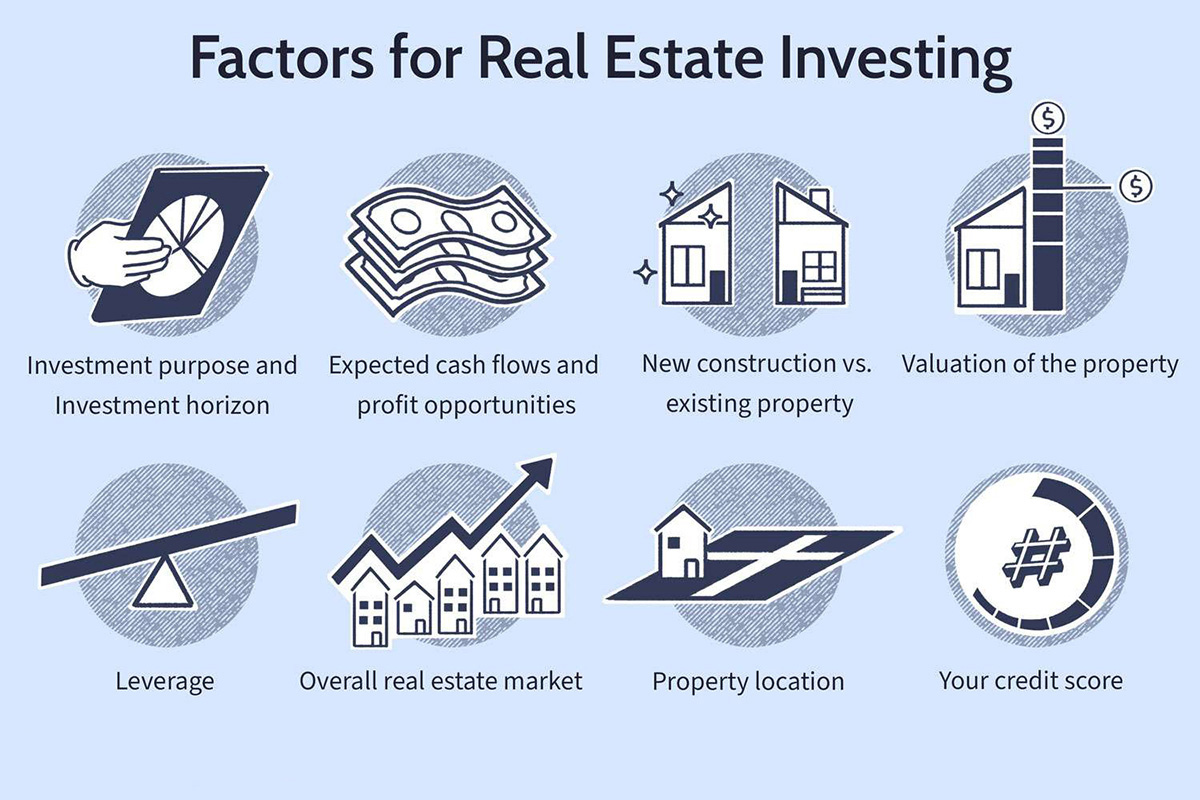Home>Finance>How To Start An Investment Fund For Real Estate


Finance
How To Start An Investment Fund For Real Estate
Modified: January 16, 2024
Learn how to start an investment fund for real estate and secure your financial future with valuable tips and insights in finance.
(Many of the links in this article redirect to a specific reviewed product. Your purchase of these products through affiliate links helps to generate commission for LiveWell, at no extra cost. Learn more)
Table of Contents
- Introduction
- Understanding Investment Funds
- Deciding on the Type of Real Estate Investment Fund
- Legal and Regulatory Considerations
- Setting Up the Fund Structure
- Raising Capital for the Investment Fund
- Identifying and Evaluating Real Estate Investments
- Acquiring and Managing Real Estate Assets
- Fund Reporting and Investor Communication
- Exiting and Liquidating the Fund
- Conclusion
Introduction
Welcome to the world of real estate investment funds! If you’re looking to start your own investment fund for real estate, you’ve come to the right place. Whether you’re a seasoned investor or new to the world of finance, this comprehensive guide will provide you with valuable insights and step-by-step guidance on how to get started.
Real estate investment funds have gained immense popularity in recent years. These funds allow investors to pool their capital together to invest in a diversified portfolio of real estate assets. By investing in a fund, individuals can access the benefits of real estate investing, including potential returns, diversification, and professional management, without the need for large amounts of capital or the complexities of direct property ownership.
Starting an investment fund for real estate can be an exciting and rewarding venture. However, it’s important to approach this endeavor with careful planning and preparation. From understanding the different types of funds to navigating legal and regulatory considerations, there are several crucial steps to take in order to ensure success.
In this guide, we will cover each stage of setting up an investment fund for real estate. We’ll explore the various fund structures, discuss legal and regulatory considerations, and provide insights into raising capital, identifying suitable investments, managing assets, and more. By the end of this guide, you’ll have a comprehensive understanding of how to start and navigate your own real estate investment fund.
Now, let’s dive into the world of investment funds for real estate and uncover the key steps to launch your own successful venture.
Understanding Investment Funds
Before diving into the specifics of starting a real estate investment fund, it’s important to have a clear understanding of what investment funds are and how they operate. An investment fund is a collective investment vehicle in which investors pool their money together to invest in a diversified portfolio of assets, managed by professional fund managers.
Real estate investment funds, specifically, focus on investing in a range of real estate assets, such as residential, commercial, industrial, or retail properties. These funds provide investors with exposure to the real estate market, allowing them to benefit from potential capital appreciation, rental income, and other returns generated by the underlying properties.
Investment funds offer several key advantages for individuals looking to invest in real estate:
- Diversification: By pooling together investors’ capital, investment funds can invest in multiple properties across different locations and sectors. This diversification helps to spread out the risk and minimize the impact of any single property’s performance on the overall fund returns.
- Professional Management: Real estate investment funds are managed by experienced fund managers who have in-depth knowledge and expertise in the real estate industry. These professionals handle the day-to-day operations, property selection, acquisition, and management, allowing investors to benefit from their expertise without having to actively manage properties themselves.
- Liquidity: Unlike direct property ownership, where it can take time and effort to sell a property, investment funds offer greater liquidity. Investors can typically buy or sell their shares in the fund at regular intervals, providing them with greater flexibility and accessibility to their investments.
- Scale: Investment funds have the advantage of scale. By pooling together large amounts of capital, funds can access larger and more lucrative real estate opportunities that may not be feasible for individual investors. This enables investors to participate in high-value properties and projects that can generate substantial returns.
It’s important to note that there are different types of real estate investment funds, each with its own structure and investment strategy. These include:
- Open-end Funds: These funds allow investors to buy or sell shares at any time, and the fund continuously issues and redeems shares based on investor demand.
- Closed-end Funds: Unlike open-end funds, closed-end funds have a fixed number of shares and are not obligated to redeem shares upon investor request. These funds are typically listed on an exchange and trade like traditional stocks.
- REITs (Real Estate Investment Trusts): REITs are publicly listed companies that own, operate, or finance income-generating properties. Investors can buy and sell shares of REITs on stock exchanges, and they are required to distribute a significant portion of their taxable income to shareholders in the form of dividends.
By understanding the different types of investment funds and their advantages, you can choose the most suitable structure for your real estate investment fund. In the next section, we will delve into the process of deciding on the type of real estate investment fund that aligns with your goals and preferences.
Deciding on the Type of Real Estate Investment Fund
When starting a real estate investment fund, one of the crucial decisions you’ll need to make is choosing the type of fund that best aligns with your investment goals, risk tolerance, and target investor base. There are various types of real estate investment funds, each with its own characteristics and considerations.
Here are three common types of real estate investment funds:
- Private Equity Funds: Private equity real estate funds are typically structured as closed-end funds. They have a fixed lifespan and are designed for a specific investment strategy, such as acquiring distressed properties, developing land, or investing in specific property sectors. These funds often target higher returns and require a longer investment horizon. They are suitable for sophisticated investors and institutions willing to commit capital for a longer period of time.
- Core Funds: Core real estate funds focus on stable income-producing properties with low risk. These funds invest in properties that are fully leased or have reliable rental income. Core funds typically offer lower returns but aim to provide steady cash flow and capital preservation. They are less volatile compared to other types of funds and are suitable for more conservative investors seeking stable income and lower risk exposure.
- Value-Add/Opportunistic Funds: Value-add or opportunistic real estate funds target properties with the potential for significant value enhancement through renovations, repositioning, or development. These funds focus on opportunities where active management and value creation can generate higher returns. Value-add funds typically involve higher risk and require an experienced management team to execute the value-add strategies. These funds are suitable for investors seeking higher potential returns and are willing to take on more risk.
It’s important to carefully analyze your investment strategy, risk tolerance, and market conditions when deciding on the type of real estate investment fund. Consider the following factors:
- Investment Horizon: Determine how long you are willing to commit your capital and the timeframe for achieving your investment objectives. Some funds have long-term commitment periods, while others offer more flexibility for investors to exit.
- Risk Profile: Assess your risk appetite and tolerance. Evaluate the level of risk associated with each type of fund, considering factors such as market conditions, asset classes, and investment strategies.
- Return Expectations: Establish your target returns and income requirements. Different types of funds offer varying levels of return potential, and it’s essential to align your expectations with the fund’s investment strategy and objectives.
- Investor Base: Consider the type of investors you want to attract. Different funds may appeal to institutional investors, high-net-worth individuals, or retail investors. Understand their preferences and requirements to structure the fund accordingly.
Once you have determined the type of real estate investment fund that suits your goals, it’s crucial to outline the fund’s investment strategy, including the target property types, geographic focus, expected returns, and risk management approach. This will help attract potential investors and provide clarity for the fund’s operations.
In the next section, we’ll discuss the legal and regulatory considerations involved in setting up a real estate investment fund.
Legal and Regulatory Considerations
When establishing a real estate investment fund, it’s crucial to navigate the legal and regulatory landscape to ensure compliance and protect the interests of both the fund managers and investors. Understanding and adhering to the legal requirements can help you operate your fund smoothly and minimize potential risks and liabilities. Here are some key considerations:
- Legal Structure: Choose an appropriate legal structure for your investment fund. Common structures include limited partnerships, limited liability companies (LLCs), or corporations. Consult with legal professionals to determine the most suitable structure based on factors such as liability protection, tax implications, and governance requirements.
- Fund Formation: Follow the legal requirements for fund formation, which may include filing necessary documents, drafting a private placement memorandum (PPM), and creating the fund’s governing documents, such as the partnership agreement or operating agreement.
- Securities Laws: Comply with securities laws and regulations, especially if you plan to raise capital from investors through the sale of securities. Depending on your jurisdiction, you may need to register the securities offering or qualify for an exemption to ensure compliance with securities regulations.
- Investment Adviser Registration: If you plan to provide investment advice or manage the fund’s assets, you may need to register as an investment adviser with the appropriate regulatory authorities. This can vary based on your jurisdiction and the size of your assets under management. Consult with legal and regulatory experts to determine the specific requirements in your area.
- Disclosure and Investor Protection: Ensure transparency and investor protection by providing accurate and comprehensive disclosure documents, such as the private placement memorandum (PPM) or offering memorandum. These documents should outline the fund’s objectives, investment strategies, risks, fees, and any conflicts of interest. It is important to provide investors with all material information to make informed investment decisions.
- Anti-Money Laundering (AML) and Know Your Customer (KYC) Compliance: Establish robust AML and KYC procedures to prevent money laundering and comply with regulations pertaining to customer identification, due diligence, and reporting. Know your investor (KYI) requirements are particularly important to ensure the source of funds is legitimate and to mitigate the risk of fraudulent activities.
- Tax Considerations: Understand the tax implications of your fund structure and investment strategy. Consult with tax professionals to ensure compliance with local tax laws and optimize tax efficiency for both the fund and its investors.
It is important to consult with legal and regulatory experts who specialize in investment funds or real estate to ensure full compliance with the applicable laws and regulations in your jurisdiction. Non-compliance can lead to severe penalties, reputational damage, and hinder the growth and success of your real estate investment fund.
By diligently addressing the legal and regulatory considerations from the outset, you can establish a strong foundation for your fund and provide a secure and compliant investment vehicle for your investors. In the next section, we will discuss the steps involved in setting up the structure of your real estate investment fund.
Setting Up the Fund Structure
Once you have determined the type of real estate investment fund and navigated the legal and regulatory considerations, the next step is to set up the structure of your fund. The fund structure will determine how the fund is organized, managed, and operated.
Here are some key steps involved in setting up the fund structure:
- Choose a Fund Manager: A fund manager is responsible for overseeing the operations and investments of the fund. You can either act as the fund manager yourself or hire a professional management team with the necessary expertise in real estate investments.
- Allocate Roles and Responsibilities: Clearly define the roles and responsibilities within your fund structure. This includes appointing key personnel such as a chief investment officer, portfolio manager, asset manager, and compliance officer. Each role should have clearly defined responsibilities to ensure effective management and decision-making.
- Create the Fund’s Governance Documents: Draft the necessary governance documents, such as the partnership agreement or operating agreement, which outline the rights and obligations of the fund manager and investors. These documents should cover topics such as capital contributions, profit-sharing, decision-making processes, and fund dissolution procedures.
- Establish Fund Administration: Set up fund administration services to handle administrative tasks such as accounting, investor reporting, compliance, and regulatory filings. This can be outsourced to a third-party fund administrator or managed in-house, depending on the size and complexity of your fund.
- Implement Risk Management Framework: Develop a robust risk management framework to identify, assess, and mitigate potential risks associated with real estate investments. This includes conducting thorough due diligence on potential investments, implementing internal controls, and monitoring market and industry trends.
- Consider External Service Providers: Depending on the needs of your fund, you may need to engage external service providers such as auditors, legal advisors, tax professionals, and custodians. These professionals can provide specialized expertise and ensure compliance with legal and regulatory requirements.
- Develop Investor Documentation: Prepare investor documentation, including the private placement memorandum (PPM) or offering memorandum, subscription agreements, and investor onboarding materials. These documents should clearly communicate the fund’s investment strategy, risk factors, terms, and conditions, ensuring that investors have a full understanding of their investments.
It’s important to approach the fund structuring process with careful consideration and consultation with legal, tax, and regulatory experts. Each fund structure is unique and may have specific requirements based on jurisdiction and investor preferences.
As you set up the fund structure, keep in mind the importance of transparency, governance, and effective communication with your investors. Building a solid foundation for your real estate investment fund structure will help instill confidence and trust among your investors and contribute to the long-term success of your fund.
Next, let’s explore the essential steps involved in raising capital for your real estate investment fund.
Raising Capital for the Investment Fund
Raising capital is a crucial step in starting and operating a real estate investment fund. Securing adequate capital is essential for acquiring real estate assets, covering operational expenses, and generating returns for investors. Here are some key steps involved in raising capital for your investment fund:
- Define Your Target Investors: Determine the profile of your ideal investors, such as institutional investors, high-net-worth individuals, or retail investors. Understanding your target investors’ preferences, investment goals, and risk tolerance will help you tailor your marketing and fundraising efforts more effectively.
- Create a Compelling Investment Proposition: Develop a strong investment proposition that highlights the unique value proposition of your fund. Clearly articulate the fund’s investment strategy, track record (if applicable), potential returns, and any competitive advantages or niche expertise that sets your fund apart from others.
- Build a Network of Potential Investors: Leverage your existing network and expand it to connect with potential investors. Attend industry events, join professional organizations, and utilize social media platforms to establish relationships and create a network of individuals and institutions interested in real estate investing.
- Engage with Investor Advisors and Placement Agents: Consider partnering with investor advisors or placement agents who can introduce your fund to their network of investors. These professionals have established relationships and can provide valuable guidance on fundraising strategies and investor outreach.
- Prepare a Comprehensive Marketing Package: Create a compelling marketing package that includes a pitch deck, fund overview, investment highlights, and supporting materials such as case studies or market research. These materials should effectively communicate the fund’s investment thesis, track record, and potential returns to attract potential investors.
- Conduct Investor Presentations and Roadshows: Organize investor presentations and roadshows to showcase your investment fund to potential investors. These events provide an opportunity to build rapport, answer questions, and address any concerns that potential investors may have.
- Offer Flexible Investment Structures: Consider offering different investment structures such as different classes of shares or tailored investment options to accommodate the needs and preferences of various investors. This can include different minimum investment amounts, lock-up periods, or fee structures.
- Comply with Applicable Fundraising Regulations: Ensure compliance with various regulations governing fundraising, including securities laws and regulations. Understand the rules and requirements for soliciting and accepting investments from different types of investors, and work with legal professionals to ensure full compliance.
- Nurture and Maintain Investor Relationships: Once you secure investors, focus on nurturing and maintaining the relationship. Provide regular updates, performance reports, and transparent communication to keep investors informed and engaged. Building strong relationships and delivering on promises can help foster long-term investor trust and loyalty.
Raising capital for an investment fund requires strategic planning, effective communication, and a thorough understanding of investor needs and preferences. It’s important to approach the fundraising process with professionalism, transparency, and a genuine commitment to delivering value to your investors.
In the next section, we’ll explore the process of identifying and evaluating real estate investment opportunities for your fund.
Identifying and Evaluating Real Estate Investments
Identifying and evaluating real estate investments is a critical aspect of managing a successful investment fund. The success and profitability of your fund will largely depend on your ability to find attractive investment opportunities and conduct thorough due diligence. Here are some key steps involved in the process:
- Establish Investment Criteria: Define your investment criteria based on the fund’s strategy, risk tolerance, and target returns. This will serve as a guideline for identifying suitable real estate investments.
- Conduct Market Research: Stay updated on market trends, economic indicators, and local factors that may impact the real estate market. Analyze supply and demand dynamics, rental rates, vacancy rates, and demographics to identify markets with potential investment opportunities.
- Source Potential Investments: Use a variety of methods to source potential real estate investments, such as networking, building relationships with brokers, attending industry events, and leveraging online listing platforms. Consider off-market deals that may offer unique advantages.
- Perform Due Diligence: Once you identify potential investment opportunities, conduct thorough due diligence to assess the viability and risk profile of each property. This includes reviewing financials, property records, contracts, permits, and conducting property inspections.
- Analyze Financials: Evaluate the financials of the investment, including rental income, expenses, debt obligations, and cash flows. Assess the potential for value appreciation or value-add opportunities through renovations, repositioning, or development.
- Evaluate Risk Factors: Identify and assess the risks associated with each investment, including market risk, tenant risk, regulatory risk, and environmental factors. Consider the potential impact of these risks on the fund’s overall risk profile.
- Consider Exit Strategy: Evaluate the potential exit strategies for each investment, whether through sale, refinancing, or holding for long-term income generation. Assess the market conditions and potential returns for each exit strategy.
- Perform Investment Analysis: Analyze the investment’s potential returns, including cash flow projections, internal rate of return (IRR), return on investment (ROI), and other relevant financial metrics. Compare the investment against your fund’s target returns and investment criteria.
- Seek Expert Advice: Consult with real estate professionals, such as appraisers, legal advisors, and property managers, to gain insights and expertise during the evaluation process. Their expertise can help you make informed decisions and mitigate potential risks.
- Make Informed Investment Decisions: After conducting thorough due diligence and analysis, make informed investment decisions based on the investment’s alignment with your fund’s strategy, risk-reward profile, and potential for achieving target returns.
It’s vital to approach the process of identifying and evaluating real estate investments with a disciplined and systematic approach. Careful analysis, thorough due diligence, and expert advice will help you select high-quality investments that align with your fund’s objectives and maximize the potential for returns.
In the next section, we’ll discuss the process of acquiring and managing real estate assets within your investment fund.
Acquiring and Managing Real Estate Assets
Acquiring and managing real estate assets is a core function of a real estate investment fund. This process involves strategic decision-making, effective asset management, and maximizing the performance of your portfolio. Here are the key steps involved in acquiring and managing real estate assets:
- Refine Investment Strategy: Continuously evaluate and refine your investment strategy based on market conditions, investor preferences, and fund performance. This will help guide your acquisition efforts and ensure alignment with your fund’s objectives.
- Identify Target Properties: Source and identify target properties that meet your investment criteria. Leverage your network, engage with brokers, conduct market research, and utilize technology platforms to find potential investments.
- Perform Due Diligence: Conduct thorough due diligence on potential properties to assess their financials, legal and regulatory compliance, physical condition, market dynamics, and any other relevant factors. Engage professionals such as inspectors, appraisers, and legal advisors to assist with the due diligence process.
- Negotiate and Structure Deals: Negotiate favorable purchase terms, including price, financing, and other contractual terms. Structure the deals based on your fund’s requirements, taking into account factors such as investment horizons, risk appetite, and potential returns.
- Secure Financing: Arrange financing for property acquisitions, whether through traditional bank loans, private lenders, or other financing options. Consider factors such as interest rates, loan terms, and the impact on the fund’s overall capital structure and cash flow.
- Complete the Acquisition Process: Fulfill all legal and administrative requirements to complete the property acquisition. This may involve signing purchase agreements, transferring titles, and complying with local regulations and tax obligations.
- Implement Asset Management Strategies: Develop and execute asset management strategies to enhance the value and performance of the properties in your portfolio. This may involve property renovations, lease negotiations, tenant management, and proactive maintenance to optimize income and property appreciation.
- Monitor and Review Performance: Continuously monitor the performance of your real estate assets to ensure they meet the expected financial and operational objectives. Regularly review rental income, expenses, maintenance reports, and market trends to identify opportunities for improvements and address any challenges.
- Manage Cash Flow and Reporting: Effectively manage the cash flow from rental income, property expenses, and debt obligations. Implement proper accounting, financial reporting, and investor communication procedures to keep stakeholders informed about the financial performance and outlook of the fund.
- Consider Portfolio Optimization: Regularly assess your portfolio to optimize its composition and performance. Evaluate the potential for property sales, acquisitions, or repositioning to rebalance your portfolio and align it with changing market conditions and investment objectives.
Effective asset acquisition and management are crucial to the success of your real estate investment fund. By diligently following these steps and implementing sound asset management strategies, you can enhance the performance of your real estate assets and maximize returns for your investors.
In the next section, we’ll explore fund reporting and investor communication, which are vital for maintaining transparency and building trust with your investors.
Fund Reporting and Investor Communication
Fund reporting and investor communication are essential components of managing a real estate investment fund. Regular and transparent communication with investors helps build trust, keep stakeholders informed, and ensure a positive investor experience. Here are the key aspects of fund reporting and investor communication:
- Regular Performance Updates: Provide regular performance updates to investors, detailing the fund’s financial results, property performance, and overall portfolio performance. This can be done through quarterly or annual reports that include key metrics, such as return on investment, cash flow, occupancy rates, and any other relevant data.
- Investor Statements: Provide individual investor statements that outline their investments and contribution, distributions, and any other relevant information. These statements should be clear, concise, and easily understandable, helping investors track their investments and assess their returns.
- Timely Distribution Reporting: Communicate the timing and amounts of distributions to investors, ensuring clarity regarding how and when they will receive their investment returns or income distributions. Providing transparency and timely communication around distributions helps manage investor expectations and fosters trust.
- Investor Meetings and Update Calls: Organize periodic investor meetings, conference calls, or webinars to discuss the fund’s performance, investment strategy updates, and address any questions or concerns. These interactions provide an opportunity to engage directly with investors, foster relationships, and provide a platform for open communication.
- Investor Relations Websites: Develop a dedicated investor relations website or portal to provide access to important fund information, reports, updates, and other relevant documents. This centralized platform allows investors to access information easily and facilitates efficient communication.
- Ad-Hoc Communications: Be proactive in addressing investor inquiries and providing prompt responses to questions or concerns. Maintain open lines of communication to foster trust and ensure that investors feel supported and have their queries answered promptly.
- Compliance with Reporting Regulations: Adhere to any regulatory requirements governing fund reporting and investor communication. Ensure compliance with relevant regulations, including reporting to regulatory authorities, filing necessary forms, and providing required disclosures.
- Transparency and Full Disclosure: Provide clear, accurate, and transparent information to investors. Disclose all relevant material information, including risk factors, fund performance, and any changes or developments that may impact investor returns.
- Educational Materials: Provide educational materials and resources to help investors better understand the fund’s investment strategy, real estate market dynamics, and the overall industry. This helps investors make more informed investment decisions and fosters a sense of partnership and trust.
- Proactive Problem Resolution: Address any issues or concerns raised by investors in a timely and professional manner. Take proactive steps to resolve problems, provide solutions, and ensure that investors’ needs are met throughout their investment journey.
Effective fund reporting and investor communication play a vital role in maintaining transparency, managing relationships, and fostering trust between the fund manager and investors. By consistently providing timely and accurate information, addressing investor inquiries, and demonstrating a commitment to their success, you can build strong and long-lasting partnerships with your investors.
In the final section, we’ll discuss the process of exiting and liquidating the fund.
Exiting and Liquidating the Fund
Exiting and liquidating the fund is a crucial phase in the life cycle of a real estate investment fund. It involves executing a well-planned strategy to efficiently wind down the fund and distribute the proceeds to investors. Here are the key steps involved in the process:
- Define Exit Strategy: Determine the exit strategy of the fund, considering factors such as the fund’s investment horizon, market conditions, and investor preferences. Common exit strategies include selling properties, refinancing, or holding properties for long-term income generation.
- Monitor Market Conditions: Continuously monitor market conditions and economic factors to identify favorable opportunities for implementing the exit strategy. Evaluate the potential returns and risks associated with each exit option.
- Prepare Properties for Sale: If the exit strategy involves selling properties, prepare the assets for sale by conducting property inspections, addressing maintenance issues, and staging the properties if necessary. Engage with real estate professionals and brokers to market the properties effectively and maximize their market value.
- Marketing and Sales Process: Develop a comprehensive marketing strategy to attract potential buyers and generate interest in the properties. Showcase the value proposition of the properties and provide detailed financial and property information to potential buyers during the due diligence process.
- Negotiate and Execute Sales Agreements: Engage in negotiations with potential buyers and execute sales agreements that outline the terms and conditions of the property sales. Ensure that all legal, financial, and regulatory obligations are met during the sales process.
- Distribute Proceeds: Distribute the proceeds from property sales or other investment exits to the fund investors in accordance with the fund’s distribution policy. Ensure that the distributions are executed accurately and on a timely basis, taking into account any regulatory requirements or tax implications.
- Wind Down Operations: Close out any remaining fund operations, including the finalization of accounting and auditing procedures, regulatory filings, and the termination of any ongoing contracts or agreements associated with the fund.
- Communicate with Investors: Maintain open and transparent communication with investors throughout the liquidation process, providing regular updates on the progress, timelines, and any relevant information regarding the exit and distribution of proceeds.
- Ensure Compliance: Abide by all legal, regulatory, and tax requirements during the liquidation process. Comply with reporting obligations, final tax filings, and any other necessary regulatory filings.
- Close Out and Dissolve the Fund: Once all funds have been distributed and all necessary obligations have been fulfilled, initiate the formal process to dissolve the investment fund. This may involve legal filings and the completion of any necessary paperwork for dissolution.
Exiting and liquidating the fund requires careful planning, thorough execution, and effective communication with investors. By strategically implementing the exit strategy, managing the sales process, and providing clear and transparent updates to investors, you can successfully wind down the fund and conclude the investment cycle.
Congratulations on completing this comprehensive guide on starting and managing a real estate investment fund! By following these steps and considering the various aspects of fund formation, acquisition, management, and liquidation, you are well-equipped to embark on a successful journey in the world of real estate investment funds.
Should you have any further questions or assistance with your investment fund or any other topic, feel free to reach out. Best of luck with your endeavors!
Conclusion
Starting and managing a real estate investment fund requires careful planning, diligent execution, and thoughtful decision-making. By following the steps outlined in this guide, you can navigate the complexities of the industry and set yourself up for success. From understanding different types of investment funds to complying with legal and regulatory requirements, each stage is crucial in creating a solid foundation for your fund.
Ensuring effective communication and transparency with investors, diligently identifying and evaluating real estate investments, and taking strategic steps to acquire, manage, and exit assets are key elements that contribute to the overall success of your fund. Additionally, staying up-to-date with market trends, engaging with industry professionals, and continuously refining your investment strategy will help you stay competitive and maximize returns.
Remember that building trust and maintaining strong relationships with investors are paramount. Regular reporting, transparent communication, and addressing investor concerns in a timely manner will foster long-term partnerships and contribute to the growth of your fund.
As you embark on your journey to start and manage a real estate investment fund, remember that the guidance provided in this guide serves as a roadmap. However, it is crucial to consult with legal, financial, and regulatory professionals who can provide tailored advice based on your specific circumstances and jurisdiction.
By combining your deep knowledge of the real estate industry with a strategic approach, adaptability to changing market conditions, and a focus on delivering value to your investors, you can navigate the complexities of the investment fund landscape and achieve success in the exciting realm of real estate investing.
Good luck with your real estate investment fund, and may it be a vehicle for profitable investments and financial growth for both you and your investors!














